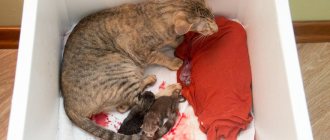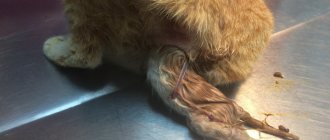- What can an owner do to help a cat during childbirth?
- What to do after giving birth to a cat?
Childbirth in a cat is a natural process that ends pregnancy and involves the fetus leaving the uterus through the cervix and vagina (birth canal).
First birth of a cat
As a rule, experienced cats themselves know what to do. But if a cat gives birth for the first time, problems may arise, since the cat does not have a good idea of what is happening to it. And in order to know how to help a cat give birth for the first time, you need to understand that childbirth is a lot of stress for a cat.
The first birth of a cat: what should the owner do? First of all, you need to prepare a cozy place for childbirth in advance. As a rule, a spacious box serves as a delivery room, and the sides should not be too high so that the cat can easily get inside. The “birthing room” should be located in a quiet, secluded place.
Also, to help your cat give birth for the first time, you need to prepare:
- Surgical gloves.
- Cotton buds.
- Sharp scissors.
- Clean cloth (cotton) or diaper.
- Clean towels (terry).
- Cotton buds.
- Gauze or cotton swabs.
- Boiled thread.
- Powdered milk formula (from a veterinary pharmacy or pet store).
- Pipette or rubber bulb.
- Syringe.
- Container for used materials.
- Liquid antiseptic (veterinary).
- Antibiotic ointment.
It is better to put everything you need in one place in advance (about a week before the expected date of birth). And don’t forget to put in a visible place the phone number of a veterinarian who can tell you what to do or come if necessary.
Signs and symptoms of impending labor
When a cat's pregnancy begins to reach 2 months, tension increases in the house. The owners are worried: when will it be? You should take a close look at the pet. Only careful observation of the expectant mother will help determine that labor is about to begin. The signs of this are as follows:
- The cat begins to lose its appetite, its movements become sluggish and limited. This is the clearest sign that labor will begin soon.
- The furry mommy is looking for a secluded place, looking around the entire apartment, sniffing corners, even opening cabinets with her paw. Some owners prepare a box in advance for the woman in labor with a piece of a warm blanket inside, but the animal may not approve of it and continue searching.
- A couple of hours before the birth process begins, the cat’s mucous plug comes out and vaginal discharge appears.
- If you closely examine the belly of the expectant mother, you will notice how the nipples are swollen, as well as the colostrum that appears from them.
It is easier for women to put themselves in the place of a cat giving birth and imagine how she feels and how she is going through. But male owners usually have no idea what will happen and how. It is advisable for them to read special literature in advance, become familiar with the physiology of the cat, and then errors during obstetric care will be reduced to a minimum.
Cat before giving birth
Many owners ask how their cat behaves before giving birth. This is necessary to know in order to prepare for the cat’s birth and not miss its beginning.
What does a cat do before giving birth?
A few hours before giving birth, the cat begins to show anxiety. From this moment on, it is better to stay nearby in order to provide assistance to your pet if necessary.
Active washing, as the cat’s genitals increase in size and turn pink. The cat should not have any discharge before giving birth.
Decreased activity. Before giving birth, the cat's behavior becomes apathetic and detached, she looks bored. Don't try to entertain her.
Decreased appetite. Water must continue to be available at all times.
Arching as during contractions. This trait of a cat's behavior before giving birth is explained by short contractions of the uterus.
Also, a cat before giving birth may behave somewhat unusually: meow loudly, seem scared, try to hide in a secluded corner. Therefore, a few days before the expected date of birth, block the cat’s access to hard-to-reach places.
What can the owner do to ease the cat’s condition before giving birth: be nearby, stroke if the cat allows it, talk in an even, gentle voice.
How does a cat give birth?
Another common question from owners is how to tell if a cat is in labor. The beginning of labor in a cat is marked by contractions - contractions of the uterus. Contractions in a cat begin several hours before the kittens appear and increase gradually. You should take your cat to the delivery room and prepare everything you need.
Signs of labor in a cat
Owners often ask what are the signs that a cat is going into labor. The following signs will help you understand that your cat is about to give birth:
- The cat's belly takes on a pear-shaped shape - it drops.
- The cat goes to the toilet more often due to a more frequent urge to urinate.
- The birth plug comes off and mucus is released.
- The water breaks, and the cat licks itself thoroughly.
- Breathing becomes more frequent and shortness of breath is possible.
As a rule, the first kitten is born within 2 hours after the cat begins strong contractions. If the cat pushes for 3 hours or more without success, or brown discharge with an unpleasant odor appears from the vulva, immediately take the cat to the veterinarian. Surgery may be necessary.
Varieties
It is customary to distinguish two types of binges: pseudo-binges and true binges. The first include the so-called “weekend binges,” when a person drinks heavily on Friday after work, gets hungover on Saturday morning and gets drunk again in the evening, drinks less on Sunday and experiences all the discomfort from withdrawal described above on Monday. Such conditions usually arise situationally (weekends, vacations, other holidays or not so special events). At the 1st stage of alcoholism, they can last 2-4 days and are not so severe. There is an opportunity to break out of binge drinking yourself or to cope with this condition on an outpatient basis. At the 2nd stage of alcohol dependence, when the amount of alcohol consumed per day reaches a physiological maximum (1.5 liters of vodka per day or more), their duration can reach up to 5-7 days and often require medical care in a specialized clinic, the need for detoxification, ensuring the absence of access to alcohol, stabilizing basic vital functions and preventing complications. In general, the cessation of such binge drinking is associated with social and psychological factors (the need to go to work, conflict in the family, interference by officials, lack of money to buy alcohol).
True binges are most characteristic of the 3rd stage of alcoholism and are not caused by psychological reasons (“I wanted to drink,” “I had alcohol or money for it”). Although alcohol tolerance decreases at this stage, true binges can last much longer (weeks), leading to admission to a drug treatment or other hospital, or even death, for example, provided unlimited access to alcohol. Psychological reasons play virtually no role here. Work is ignored (if any), the household is completely abandoned, one’s own appearance and moral rules of behavior in society become indifferent.
How long does it take for a cat to give birth?
Another popular question from cat owners is: how long does it take for a cat to give birth?
The duration of labor in a cat should normally not exceed 12 - 18 hours (from the moment the first kitten appears).
If a cat's labor lasts longer, this is a bad sign. If the duration of labor (from the first to the last kitten) takes more than 24 hours, this is also a sign of pathology and a reason to seek help from a specialist.
If a cat’s labor lasts more than 48 hours, the probability of getting live kittens is almost zero. To save a cat and kittens, surgery is most often needed in such cases.
Duration of pregnancy in different breeds
In addition to the influence of breed, it has been found that long-haired cats bear kittens slightly longer than short-haired cats. For example, in the first case the process lasts 51-72 days, and in the second - 57-70. This feature is determined by genetics.
How long does a cat bear kittens: examples by time and for the first time
A British woman is pregnant for the first and subsequent times from 64 to 71 days. The more kittens in the womb, the longer the period.
Interesting! Often the duration of gestation is influenced by genetics and the length of pregnancy of the pet's mother.
Scottish fold and straight-eared cats give birth to babies after 61-66 days. Sometimes the period may increase by several days, this should not bother the owners.
How long a Persian cat goes pregnant for the first time depends on the above factors and heredity. Often the period is 63-69 days.
The gestation period for Siamese breeds is the longest - about 72 days.
Pregnancy of the Kurilian Bobtail lasts from 60 to 67 days. The count starts from the first day of fertilization.
Maine Coons give birth to kittens after 66-72 days. A typical litter contains 4-6 kittens. If there are more babies, then the pregnancy may end earlier, since it is more difficult for the body to cope with the load.
It is best to breed British cats after the 1st year of life. The normal duration of pregnancy is 64-68 days.
The belly becomes rounded by the end of the 6th week
Giving birth to a cat at home
It is useful for owners to know how to organize the birth of a cat at home and how to help a cat during birth at home.
What can an owner do to help a cat during childbirth?
First of all, closely monitor the birth and keep the veterinarian's phone number handy. If you see that something is wrong (for example, if the first kitten does not appear within 7 hours of the onset of strong contractions), seek professional help as soon as possible.
Stay calm and, no matter what happens, do not scream or flash in front of the cat's eyes. Ask that no one else enters the room until the cat gives birth. Talk to your cat calmly and affectionately.
How to deliver a cat
Another popular question from owners: how to deliver a cat? Make sure that when giving birth to a cat at home, the placenta does not remain inside the animal. The placenta remaining inside can cause an inflammatory process.
Please note that after each kitten there is an afterbirth, which the cat usually eats. But don't let your cat eat more than 2 afterbirths - this will cause digestive upset.
If the kitten begins to breathe inside the bubble, it may stop breathing. Take the kitten (carefully!) in your hand, lower the head down a little so that water flows out of the spout. If that doesn't help, shake your baby a little. Make sure your breathing is normal. The kitten's tongue should be pink. If he turns blue, wrap the baby in a diaper and hold him upside down for a while. As soon as the kitten squeaks, it can be given to its mother.
If your cat does not chew the umbilical cord, your job is to cut the umbilical cord for her. Pull the umbilical cord with a thread (about 2 cm from the kitten’s tummy) and cut it with disinfected scissors, wipe the cut area with an antiseptic.
Dry the babies with a soft diaper and place them on a heating pad covered with a bedding.
As a rule, after the birth is complete, the cat looks relaxed and peaceful and begins to feed the kittens. At this point, the best thing you can do to help your cat give birth is to leave her alone, after changing the bedding. Make sure your cat has food and water in his bowl. Keep other animals away from your children, including a cat if it lives in your house.
Duration of binges at different stages of alcoholism
Currently, the duration of binge drinking at different stages of alcoholism is determined by a number of factors. Let's list them in order of importance:
- Stage of the disease
- Number and duration of binge drinking in the past
- The presence of concomitant somatic, neurological and mental disorders that do not allow starting or continuing binge drinking
- Availability of family and social support that helps timely seek specialized help and stop binge drinking
- Preservation of social and moral guidelines that make continued drinking impossible (work, family, non-drinking social circle)
How many kittens can a cat give birth to?
Another logical question from owners: how many kittens can a cat give birth to at one time (the first time or the maximum number)?
As a rule, for the first time a cat can give birth to 1 – 3 kittens, since the cat’s reproductive system is not fully formed. Older cats also give birth to a small number of kittens - their reproductive function fades.
How many kittens can a cat in her prime give birth to at one time? Typically up to 6 kittens. After all, nature has endowed a cat with only 8 nipples, which means that it is difficult for a cat to feed more than 8 kittens.
However, there are exceptions. No one knows exactly how many kittens a cat can give birth to, but there have been recorded cases of the birth of 12 kittens.
Cat after birth
What to do after giving birth to a cat?
This is also a popular question among owners. The birth can be considered complete if, 1.5 - 2 hours after the birth of the last kitten, the cat has no contractions, the stomach is soft and all the placenta have come out. During this period, the main thing is to feed the cat properly and protect it from stress.
If the birth took place without complications, as a rule, after 14 days the cat recovers completely, and the kittens grow significantly.
When can a cat become pregnant after giving birth?
Owners often ask how quickly a cat can become pregnant after giving birth and can a cat become pregnant immediately after giving birth? It must be taken into account that giving birth and feeding kittens is a huge burden on the cat’s body, which exhausts the animal and can lead to diseases.
So after giving birth, the cat needs a recovery period. On average, a cat comes into heat 1 – 2 months after giving birth. But even if the cat is ready to become pregnant immediately after giving birth and begins to ask for a cat, take measures to prevent pregnancy from occurring.
The maximum number of births a cat can give birth to is once a year. In this case, the cat has the opportunity to recover from previous births and raising kittens.
When can a cat be spayed after giving birth?
Sometimes owners are interested in whether it is possible to sterilize a cat after giving birth and when can a cat be sterilized after giving birth? Veterinarians cannot answer this question unequivocally. The answer to the question of how long to sterilize a cat after giving birth depends on whether the cat is nursing kittens. If your cat is nursing kittens, you should not spay her immediately after giving birth. As a rule, veterinarians say that a cat can be sterilized no earlier than 2 months after birth. Sterilizing a cat after birth is fraught with serious complications (including death) and is possible only in exceptional cases.
The cat does not have milk after giving birth
There are several reasons why a cat does not produce milk after giving birth:
- Stress.
- Infection. In this case, treatment with antibiotics is necessary.
- Lack of maternal instinct - occurs, as a rule, in a young cat.
- Poor nutrition. Give your cat more dairy products, vitamins and protein.
- Hormonal imbalance.
In any case, you need to contact a specialist and follow his recommendations.
What to feed a cat after giving birth
Many owners are concerned about the question of what to feed their cat after giving birth. How to feed a cat that has given birth?
During the first 10 to 12 days after birth, the diet of a nursing cat should include only nutritious, natural and easily digestible foods: fermented milk, cereals and vegetables. If your cat really lacks meat, you can give boiled dietary meat.
It is better to exclude dry food: a large amount of salt and a small amount of liquid makes it difficult for a cat to produce milk after birth. However, if a cat has allergies, a sudden change in diet is contraindicated. In other cases, familiar foods are introduced into the diet of a nursing cat on the 14th day. Please note that after giving birth, your cat needs to be given foods that contain magnesium and calcium. Ask your veterinarian which supplements to choose. It is important that food for a nursing cat is always fresh. Water must be freely available.
Factors influencing gestation period
How long a pet's pregnancy will last depends on a number of factors. For example, the weight of the animal is important. If you are obese or underweight, it is more difficult for a female to bear offspring, so the timing may vary.
How many days does a cat walk: examples for the first time and how long in time
If fertilization occurs for the first time in a pet that is younger than 8 months, then it will be more difficult to bear healthy offspring. In such cases, pathologies of fetal development, as well as difficult childbirth, are often observed.
Important! Hormonal imbalances greatly affect the timing of gestation.
The presence of chronic infectious diseases leads to the fact that the due date may shift. During planning of mating, as well as pregnancy, it is necessary to carefully monitor the well-being of the pet in order to eliminate the risk of miscarriage.
Often times are even affected by weather conditions, changes in seasons or climate zones.
The cat can't give birth
Normal birth in a cat lasts no more than 18 hours. If the process is delayed, it means that the cat cannot give birth normally. What to do if the cat cannot give birth?
First of all, seek help from your veterinarian. There are many reasons for birth pathologies, and only a specialist can properly help your pet.
If 24 hours have passed since the start of labor and the cat is still unable to give birth, the kittens are most likely dead. And in this case, surgery is necessary. But first, X-ray diagnostics may be needed.
The main rule: if you see that something went wrong during the cat’s birth, contact your veterinarian as soon as possible!
The cat gives birth too quickly
When kittens are born too quickly, the birth is called precipitate. Note that rapid labor is more dangerous than prolonged labor, although it passes much faster. Usually, with rapid labor, all kittens are born in less than 1 hour.
The cause of rapid labor may be stress or miscarriage. In rare cases, rapid labor is a hereditary factor. When labor progresses too quickly, the cat experiences severe pain as the intervals between contractions become shorter. Hormones are released into the animal's blood, allowing the cervix to dilate as quickly as possible and expel the litter.











